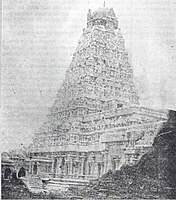Kampaheswarar Temple, Thirubuvanam
| Kampaheswarar Temple | |
|---|---|
Thirubuvanam | |
| State | Tamil Nadu |
| Country | India |
Location in Tamil Nadu | |
| Geographic coordinates | 10°59′24.1″N 79°25′59.97″E / 10.990028°N 79.4333250°E |
| Architecture | |
| Type | Dravidian architecture |
The Kampaheswarar Temple or kampa-hara-ishvarar ( kampa-hareswarar ) is a
The temple has a shrine for
Legend
As per Hindu legend, Shiva is believed to have relieved Kampa (quaking) of a king haunted by evil spirits on account of the king killing a Brahmin by mistake. This led to the name of Kampahareshvara.[1] As per another legend, Shiva is believed to have assumed the form to quench the fury of Narasimha, an avatar of Vishnu.[2]
Vaippu Sthalam
It is one of the shrines of the Vaippu Sthalams sung by Tamil Saivite Nayanar Appar.[3][4]
History

As per inscriptions found in the south wall of the temple, the shrine was constructed by the Chola king
Architecture
The temple is in
Complex
The temple is approached through a five-tiered pyramidal
There is a separate shrine for the deity
Gallery
-
Main entrance andRajagopura
-
Dwajasthambam
-
Outerprakara
-
Innergopura
-
Pillars in the mandapa
-
Vimana rear view
Notes
- ^ a b c Ayyar 1993, pp. 316-320
- ^ V., Meena (1974). Temples in South India (1st ed.). Kanniyakumari: Harikumar Arts. p. 29.
- ^ பு.மா.ஜெயசெந்தில்நாதன், தேவார வைப்புத்தலங்கள், வர்த்தமானன் பதிப்பகம், சென்னை, 2009
- ^ மூவர் தேவார வைப்புத் தலங்கள், Muvar Thevara Vaippu Thalangal, திருபுவனம் (Thirubuvanam), 6-51-11
- ^ a b c d Tourist guide to Tamil Nadu 2007, p. 71
- ISBN 9788177552997.
- ISBN 978-81-87952-12-1.
- ^ Rajarajan, R.K.K. (2021). "Stucco Images of Tribhuvanam". History Today. Journal of History and Historical Archaeology. 22: 36–45.
- (subscription required)
- ^ D., Devakunjari (1973). R., nagaswamy (ed.). The Mahadeva temple of Tillaisthanam (PDF). Damilica (Report). Vol. II. The State Department of Archaeology, Government of Tamil Nadu. p. 44.
- ^ Smith 2003, p. 193
- ^ Rao p.174
- ^ H., Sarkar (1974). The Kampahesvara temple at Thirubuvanam (PDF). Madras: Department of Archaeology, Government of Tamil Nadu. p. 9.
References
- Smith, David (2003). The Dance of Siva: Religion, Art and Poetry in South India: Volume 7 of Cambridge Studies in Religious Traditions. Cambridge University Press. p. 193. ISBN 0-521-52865-8. Retrieved 15 January 2010.
- Ayyar, P.V. Jagadisa (1993). South Indian Shrines Illustrated. New Delhi: Asian Educational Services. ISBN 81-206-0151-3.
- Tourist guide to Tamil Nadu (2007). Tourist guide to Tamil Nadu. Chennai: T. Krishna Press. ISBN 978-81-7478-177-2.
- Rao, T. A.Gopinatha (1997). Elements of Hindu iconography, Volume 2. Motilal Banarsidass Publishers. pp. 171–173. ISBN 81-208-0878-9. Retrieved 15 January 2010.












